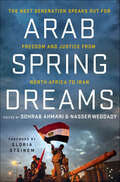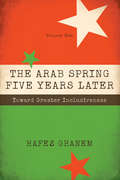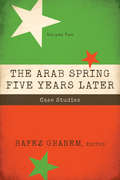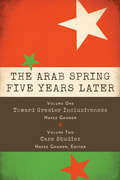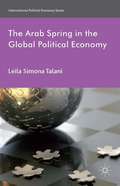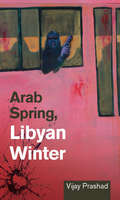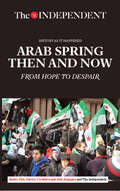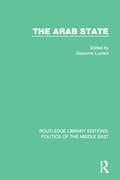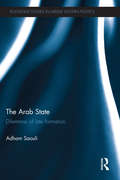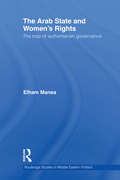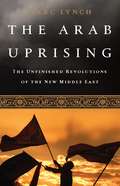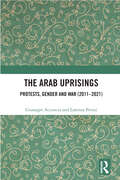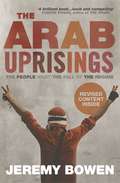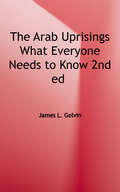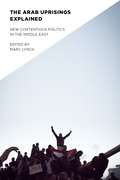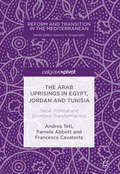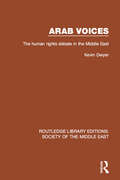- Table View
- List View
Arab Spring Dreams: The Next Generation Speaks Out for Freedom and Justice from North Africa to Iran
by Nasser Weddady and Sohrab AhmariFrom a gay man secretly mourning his lover's suicide in Morocco to a young woman denied schooling because of religious discrimination in Iran, Arab Spring Dreams spotlights some of the Middle East's most outspoken young dissidents. The essayists cover a wide range of experiences, including premarital sex, the lack of educational opportunities, teenage marriage, and the fight for political freedom. They also highlight how repressive laws and cultural mores snuff out liberty and stifle growth and consider how previous movements - particularly the American civil rights struggle - might be channeled to effect change in their own countries. Beautifully written and profoundly moving, these stories present a decisive call for change at a crucial point in the evolution of the Middle East.
The Arab Spring Five Years Later
by Hafez GhanemHafez Ghanem delivers a thorough assessment of the economic dimensions of the Arab Spring, beginning with political developments since the revolutions and the economic impact of changes in legal and institutional frameworks. Arab economies grew at healthy rates before the revolts, but the benefits of economic growth were unfairly distributed. The politically connected reaped great benefits, while educated youth could not find decent jobs, and the poor and middle class struggled to make ends meet.Ghanem advises the Arab Spring countries to adopt new economic policies and programs that enhance inclusiveness, expand the middle class, and foster growth in undeveloped regions. Key elements include strengthening economic institutions, developing small businesses, reforming the education system to better prepare Arab youth for the modern labor market, promoting gender equality with the objective of raising female labor market participation rates, and setting up programs for rural and regional development to reduce inequality and eliminate extreme poverty.
The Arab Spring Five Years Later
by Hafez GhanemThis second volume of The Arab Spring Five Years Later provides the original research papers on which volume 1 by Hafez Ghanem is based. In this edited volume, Ghanem assembles a collection of important research conducted by scholars from a variety of backgrounds to provide a deeper understanding of the economic factors that led to the Arab Spring. Chapters examine women's issues and agricultural practices in Morocco; urban transportation, small enterprises, governance, and inclusive planning in Egypt; reconstruction in Iraq; youth employment in Tunisia; education in Yemen; and more.In addition to Hafez Ghanem, contributors include Mongi Boughzala (University of Tunis ElManar, Tunisia), Emmanuel Comolet (French Agency for Development), Mohamed Tlili Hamdi (University of Sfax, Tunisia), Seiki Tanaka (University of Amsterdam), and from the Japan International Cooperation Agency (JICA), Yuriko Kameyama, Mayada Magdy, Hideki Matsunaga, Yuko Morikawa, Akira Murata, Kei Sakamoto, Masanori Yoshikawa, and Takako Yuki.
The Arab Spring Five Years Later: Toward Greater Inclusiveness (Volume #1)
by Hafez GhanemThe dilemma felt by Arab youth was captured in Tunisia by the selfimmolation in 2010 of Mohamed Bouazizi, who was frustrated by restrictions on his small street-vendingbusiness. His death became the catalyst for revolts throughout the Middle East. The frustration had been building for some time: large segments of society were denied economic progress, while the middle class was squeezed, and governments had cut back on services and public employment. Since the series of uprisings began, the debate in Arab countries has focused almost exclusively on politics and questions of national identity. However, economic issues are driving the agenda, and real economic grievances must be addressed in order for the many transitions to succeed. Hafez Ghanem gives a thorough assessment of the Arab Spring, beginning with political developments since the revolutions and changes in the legal and institutional frameworks that affect economies. Arab economies grew at healthy rates before the revolts, but thebenefits of economic growth were unfairly distributed. The politically connected reaped great benefits, while educated youth could not find decent jobs, and the poor and middle class struggled to make ends meet. Ghanem advises that Arab countries need to adopt new economic policies and programs that enhance inclusiveness, expand the middle class, and foster growth in undeveloped regions. Key elements include strengthening economic institutions, developing smallbusinesses, reforming the education system to better prepare Arab youth for the modern labor market, promoting gender equality with the objective of raising female labor market participation rates, and setting up programs for rural and regional development to reduce inequality and eliminate extreme poverty.
The Arab Spring Five Years Later: Case Studies (Volume #2)
by Hafez GhanemVolume 1 of The Arab Spring Five Years Later is based on extensive research conducted by scholars from a variety of backgrounds, including many associated with the Japan International Cooperation Agency (JICA). The original research papers are gathered involume 2 and are available for readers who wish to go even further in understanding the economic background of the Arab Spring. Papers examine women's issues and agricultural practices in Morocco; urban transportation, small enterprises, governance, and inclusive planning in Egypt; reconstruction in Iraq; youth employment in Tunisia;education in Yemen; and more. In addition to Hafez Ghanem, contributors include Mongi Boughzala (University of Tunis ElManar, Tunisia), Mohamed Tlili Hamdi (University of Sfax, Tunisia),Yuriko Kameyama (JICA), Hideki Matsunaga (JICA), Mayada Magdy (JICA), Yuko Morikawa (JICA), Akira Murata (JICA), Kei Sakamoto (JICA), Seiki Tanaka (JICA), Masanori Yoshikawa (JICA), and Takako Yuki (JICA).
The Arab Spring Five Years Later
by Hafez GhanemThis two-volume set explores in-depth the economic origins and repercussions of the Arab Spring revolts.Volume 1 of The Arab Spring Five Years Later is based on extensive research conducted by scholars from a variety of backgrounds, including many associated with the Japan International Cooperation Agency (JICA). The original research papers are gathered in volume 2 and are available for readers who wish to go even further in understanding the economic background of the Arab Spring. Papers examine women's issues and agricultural practices in Morocco; urban transportation, small enterprises, governance, and inclusive planning in Egypt; reconstruction in Iraq; youth employment in Tunisia; education in Yemen; and more.In addition to Hafez Ghanem, contributors include Mongi Boughzala (University of Tunis ElManar, Tunisia), Mohamed Tlili Hamdi (University of Sfax, Tunisia),Yuriko Kameyama (JICA), Hideki Matsunaga (JICA), Mayada Magdy (JICA), Yuko Morikawa (JICA), Akira Murata (JICA), Kei Sakamoto (JICA), Seiki Tanaka (JICA), Masanori Yoshikawa (JICA), and Takako Yuki (JICA).
The Arab Spring In The Global Political Economy
by Leila Simona TalaniAlthough it is still early for an established academic account of the motivations behind the dramatic events in the Arab world in 2010/11, Leila Simona Talani believes that it is about time to try and place this issue into the broader picture of the latest changes in the global political economy.
Arab Spring, Libyan Winter
by Vijay PrashadThe Arab Spring captivated the planet. Mass action overthrew Tunisia's Ben Ali and Egypt's Hosni Mubarak. The revolutionary wave spread to the far corners of the Arab world, from Morocco to Bahrain. It seemed as if all the authoritarian states would finally be freed, even those of the Arabian Peninsula. People's power had produced this wave, and continued to ride it out. In Libya, though, the new world order had different ideas. Social forces opposed to Muammar Qaddafi had begun to rebel, but they were weak. In came the French and the United States, with promises of glory. A deal followed with the Saudis, who then sent in their own forces to cut down the Bahraini revolution, and NATO began its assault, ushering in a Libyan Winter that cast its shadow over the Arab Spring. This brief, timely analysis situates the assault on Libya in the context of the winds of revolt that swept through the Middle East in the Spring of 2011. Vijay Prashad explores the recent history of the Qaddafi regime, the social forces who opposed him, and the role of the United Nations, NATO, and the rest of the world's superpowers in the bloody civil war that ensued. Vijay Prashad is the George and Martha Kellner Chair of South Asian History, and professor and director of international studies at Trinity College in Hartford, Connecticut. He is the author or editor of over a dozen books, including Karma of Brown Folk and, most recently, The Darker Nations: A People's History of the Third World.
Arab Spring Then and Now: From Hope to Despair (History as it Happened)
by Robert Fisk Patrick Cockburn Kim Sengupta The IndependentThree award-winning journalists dive into the 2010 uprising that engulfed North Africa and the Middle East—and its aftermath.&“The big problem with the Middle East is to get people to see it from a different perspective; to stop accepting the American version of reality, i.e. &‘terror terror terror,&’ and instead look at the question of injustice. Seeing a different perspective, that of people who suffer for example.&”—Robert Fisk, The Independent In December 2010, the &“Tunisian Revolution&” touched off a wave of protests, riots, revolutions and civil wars throughout the Middle East. Initially the world hoped for positive change—democracy, free elections, and human rights. But, by 2012 the Arab Spring had morphed into &“Arab Winter&” bringing death, destruction, and despair. The Independent&’s Robert Fisk, Patrick Cockburn, and Kim Sengupta, among the most acclaimed Middle East correspondents of our generation, examine the events of this regional tsunami that threatens to have an impact on our world for years to come.
The Arab State: New Comparative Perspectives On The Arab Gulf States (Routledge Library Editions: Politics of the Middle East #2)
by Giacomo LucianiIt has often been argued that Arab states are arbitrary political creations, lacking historical or present legitimacy. This book, first published in 1990, provides a different picture of ‘the Arab state’, drawing on historical, economic, philosophical and sociological perspectives to give a balanced and convincing view of the complex reality of contemporary Arab politics. The contributors, from the Arab countries, from Europe and the United States, investigate the roots of the nation state in the Arab world, evaluating in particular the economic bases of individual states. They discuss the evolution of Arab societies and the way this is reflected in different states, and examine the problems of domestic and international integration in the Arab context. Original and comprehensive in its findings, this is an essential text on the fundamental political structure of the Arab world. Its interdisciplinary breadth makes possible an entirely new reading of the political reality of the Middle East.
The Arab State: Dilemmas of Late Formation (Routledge Studies in Middle Eastern Politics)
by Adham SaouliThis book explores the conditions of state formation and survival in the Middle East. Based on Historical Sociology, it provides a model for study of the state in the Arab world and a theory to explain its survival. Examining states as a ‘process’, the author argues that what emerged in the Middle East in the beginning of the twentieth century are ‘social fields’—where states form and deform—and not states as defined by Max Weber. He explores the constitutions of these fields—their cultural, material and political structures—and identifies three stages of state development in which different cases can be located. Capturing the dilemmas that ‘late-forming states’ face as regimes within them cope with domestic and international pressure, the author illustrates several Middle East cases and presents a detailed analysis of state developments in Saudi Arabia and Iraq. He maintains that more than the domestic characteristics of individual states, state survival in the Middle East is also a function of the anarchic nature of the international (and by extension the regional) states-system. The first to raise the question on the survivability of the territorial states in the Middle East while engaging with both International Relations and Comparative Politics theories, this book will be of interest to students and scholars of Middle East politics, Comparative Politics and International Relations.
The Arab State and Women's Rights: The Trap of Authoritarian Governance (Routledge Studies in Middle Eastern Politics)
by Elham ManeaResearchers studying gender politics in Arab societies have been puzzled by a phenomenon common in many Arab states – while women are granted suffrage rights, they are often discriminated against by the state in their private lives. This book addresses this phenomenon, maintaining that the Arab state functions according to a certain ‘logic’ and ‘patterns’ which have direct consequences on its gender policies, in both the public and private spheres. Using the features of the Arab Authoritarian state as a basis for a theoretical framework of analysis, the author draws on detailed fieldwork and first-hand interviews to study women’s rights in three countries - Yemen, Syria, and Kuwait. She argues that the puzzle may be resolved once we focus on the features of the Arab state, and its stage of development. Offering a new approach to the study of gender and politics in Arab states, this book will be of great interest to scholars and students of gender studies, international politics and Middle East studies.
The Arab Uprising
by Marc LynchBarely a year after the self-immolation of a young fruit seller in Tunisia, a vast wave of popular protest has convulsed the Middle East, overthrowing long-ruling dictators and transforming the regionOCOs politics almost beyond recognition. But the biggest transformations of what has been labeled as the OC Arab SpringOCO are yet to come. An insider to both American policy and the world of the Arab public, Marc Lynch shows that the fall of particular leaders is but the least of the changes that will emerge from months of unrest. The far-ranging implications of the rise of an interconnected and newly-empowered Arab populace have only begun to be felt. Young, frustrated Arabs now know that protest can work and that change is possible. They have lost their fearOComeanwhile their leaders, desperate to survive, have heard the unprecedented message that killing their own people will no longer keep them in power. Even so, as Lynch reminds us, the last wave of region-wide protest in the 1950s and 1960s resulted not in democracy, but in brutal autocracy. Will the Arab worldOCOs struggle for change succeed in building open societies? Will authoritarian regimes regain their grip, or will Islamist movements seize the initiative to impose a new kind of rule?"The Arab Uprising" follows these struggles from Tunisia and Egypt to the harsh battles of Yemen, Bahrain, Syria, and Libya and to the cautious reforms of the regionOCOs monarchies. It examines the real meaning of the rise of Islamist movements in the emerging democracies, and the longterm hopes of a generation of activists confronted with the limits of their power. It points toward a striking change in the hierarchy of influence, as the old heavyweightsOCoIran, Al Qaeda, even IsraelOCohave been all but left out while oil-rich powers like Saudi Arabia and OC swing statesOCO like Turkey and Qatar find new opportunities to spread their influence. And it reveals how America must adjust to the new realities. Deeply informed by inside access to the Obama administrationOCOs decision-making process and first-hand interviews with protestors, politicians, diplomats, and journalists, "The Arab Uprising" highlights the new fault lines that are forming between forces of revolution and counter-revolution, and shows what it all means for the future of American policy. The result is an indispensible guide to the changing lay of the land in the Middle East and North Africa. "
The Arab Uprising: The Unfinished Revolutions of the New Middle East
by Marc LynchBarely a year after the self-immolation of a young fruit seller in Tunisia, a vast wave of popular protest has convulsed the Middle East, overthrowing long-ruling dictators and transforming the region's politics almost beyond recognition. But the biggest transformations of what has been labeled as the "Arab Spring" are yet to come. An insider to both American policy and the world of the Arab public, Marc Lynch shows that the fall of particular leaders is but the least of the changes that will emerge from months of unrest. The far-ranging implications of the rise of an interconnected and newly-empowered Arab populace have only begun to be felt. Young, frustrated Arabs now know that protest can work and that change is possible. They have lost their fear--meanwhile their leaders, desperate to survive, have heard the unprecedented message that killing their own people will no longer keep them in power. Even so, as Lynch reminds us, the last wave of region-wide protest in the 1950s and 1960s resulted not in democracy, but in brutal autocracy. Will the Arab world's struggle for change succeed in building open societies? Will authoritarian regimes regain their grip, or will Islamist movements seize the initiative to impose a new kind of rule? The Arab Uprising follows these struggles from Tunisia and Egypt to the harsh battles of Yemen, Bahrain, Syria, and Libya and to the cautious reforms of the region's monarchies. It examines the real meaning of the rise of Islamist movements in the emerging democracies, and the longterm hopes of a generation of activists confronted with the limits of their power. It points toward a striking change in the hierarchy of influence, as the old heavyweights--Iran, Al Qaeda, even Israel--have been all but left out while oil-rich powers like Saudi Arabia and "swing states" like Turkey and Qatar find new opportunities to spread their influence. And it reveals how America must adjust to the new realities. Deeply informed by inside access to the Obama administration's decision-making process and first-hand interviews with protestors, politicians, diplomats, and journalists, The Arab Uprising highlights the new fault lines that are forming between forces of revolution and counter-revolution, and shows what it all means for the future of American policy. The result is an indispensible guide to the changing lay of the land in the Middle East and North Africa.
The Arab Uprising
by Marc LynchBarely a year after the self-immolation of a young fruit seller in Tunisia, a vast wave of popular protest has convulsed the Middle East, overthrowing long-ruling dictators and transforming the region’s politics almost beyond recognition. But the biggest transformations of what has been labeled as the “Arab Spring” are yet to come. An insider to both American policy and the world of the Arab public, Marc Lynch shows that the fall of particular leaders is but the least of the changes that will emerge from months of unrest. The far-ranging implications of the rise of an interconnected and newly-empowered Arab populace have only begun to be felt. Young, frustrated Arabs now know that protest can work and that change is possible. They have lost their fear-meanwhile their leaders, desperate to survive, have heard the unprecedented message that killing their own people will no longer keep them in power. Even so, as Lynch reminds us, the last wave of region-wide protest in the 1950s and 1960s resulted not in democracy, but in brutal autocracy. Will the Arab world’s struggle for change succeed in building open societies? Will authoritarian regimes regain their grip, or will Islamist movements seize the initiative to impose a new kind of rule? The Arab Uprisingfollows these struggles from Tunisia and Egypt to the harsh battles of Yemen, Bahrain, Syria, and Libya and to the cautious reforms of the region’s monarchies. It examines the real meaning of the rise of Islamist movements in the emerging democracies, and the longterm hopes of a generation of activists confronted with the limits of their power. It points toward a striking change in the hierarchy of influence, as the old heavyweights-Iran, Al Qaeda, even Israel-have been all but left out while oil-rich powers like Saudi Arabia and “swing states” like Turkey and Qatar find new opportunities to spread their influence. And it reveals how America must adjust to the new realities. Deeply informed by inside access to the Obama administration’s decision-making process and first-hand interviews with protestors, politicians, diplomats, and journalists,The Arab Uprisinghighlights the new fault lines that are forming between forces of revolution and counter-revolution, and shows what it all means for the future of American policy. The result is an indispensible guide to the changing lay of the land in the Middle East and North Africa.
The Arab Uprising
by Marc LynchBarely a year after the self-immolation of a young fruit seller in Tunisia, a vast wave of popular protest has convulsed the Middle East, overthrowing long-ruling dictators and transforming the region's politics almost beyond recognition. But the biggest transformations of what has been labeled as the "Arab Spring" are yet to come.An insider to both American policy and the world of the Arab public, Marc Lynch shows that the fall of particular leaders is but the least of the changes that will emerge from months of unrest. The far-ranging implications of the rise of an interconnected and newly-empowered Arab populace have only begun to be felt. Young, frustrated Arabs now know that protest can work and that change is possible. They have lost their fear--meanwhile their leaders, desperate to survive, have heard the unprecedented message that killing their own people will no longer keep them in power. Even so, as Lynch reminds us, the last wave of region-wide protest in the 1950s and 1960s resulted not in democracy, but in brutal autocracy. Will the Arab world's struggle for change succeed in building open societies? Will authoritarian regimes regain their grip, or will Islamist movements seize the initiative to impose a new kind of rule?The Arab Uprising follows these struggles from Tunisia and Egypt to the harsh battles of Yemen, Bahrain, Syria, and Libya and to the cautious reforms of the region's monarchies. It examines the real meaning of the rise of Islamist movements in the emerging democracies, and the longterm hopes of a generation of activists confronted with the limits of their power. It points toward a striking change in the hierarchy of influence, as the old heavyweights--Iran, Al Qaeda, even Israel--have been all but left out while oil-rich powers like Saudi Arabia and "swing states" like Turkey and Qatar find new opportunities to spread their influence. And it reveals how America must adjust to the new realities. Deeply informed by inside access to the Obama administration's decision-making process and first-hand interviews with protestors, politicians, diplomats, and journalists, The Arab Uprising highlights the new fault lines that are forming between forces of revolution and counter-revolution, and shows what it all means for the future of American policy. The result is an indispensible guide to the changing lay of the land in the Middle East and North Africa.
The Arab Uprisings: Protests, Gender and War (2011-2021)
by Giuseppe Acconcia Lorenza PeriniThis book investigates the role of social groups in mobilizing resources for protests in repressive contexts. In particular, it examines the impact of organizations and informal groups on individual engagement in the protests developed in 2010–2011 in Tunisia, Egypt, and Syria. Empirical analysis draws on a wave of events and protests that took place between 2010 and 2021. It explores how, in repressive contexts, spontaneous groups and more established and formal organizations continuously switch from one form to another, transforming themselves faster than they would do in democratic contexts.
The Arab Uprisings: The People Want the Fall of the Regime
by Jeremy BowenJeremy Bowen has been the BBC's Middle East correspondent for twelve years and has been on the ground for them as the recent revolutions have swept through the region. Realising this as a game-changing moment in the history of the Middle East, The Arab Uprisingscaptures the thoughts and feelings of the people involved as the events unfolded, putting these revolutions in their political context, and using them as a prism through which to understand the broader history and landscape of the Middle East. The book will look at the world the demonstrators rejected and its Arab dictators. The author will examine brutal police states, tribal loyalty and foreign help. The West's response and Israel's too, will form part of the narrative. This is an urgent and authoritative account of the seismic political changes rocking the Middle East, from one of the foremost reporters of our time.
The Arab Uprisings
by Jeremy BowenFor many living in the Arab world, change felt like a distant dream. But the desperate act of a young Tunisian man in October 2010 would be the touchpaper that united people in anger and frustration and sparked a series of extraordinary events that would change the lives of millions, the impact of which is still being played out today. Award-winning journalist Jeremy Bowen has been the BBC's Middle East Editor since 2005 and was on the ground for them as revolution swept through the region. Recognising this as a game-changing moment in the history of the Middle East, through the thoughts and feelings of the people involved, The Arab Uprisings captures the violent foment of those heady days and follows the story as it has evolved over the months. With unparalleled access, Bowen examines how the unforeseen but infectious rebellion shook the Middle East and unseated its dictators, whilst also lifting the lid on the brutal police states, tribal loyalty, the influence of social media and the part that foreign help played. Putting these revolutions in their political context and giving insight into the broader history and evolving landscape of the Middle East, it is the story of a change that had once seemed impossible; how it happened and what it means. This is an urgent and authoritative account of a year like no other before it, told by one of the foremost reporters of our time. eremy Bowen is Middle East Editor for the BBC, having reported from Jerusalem for twelve years. He is the author of two previous books: Six Days and War Stories.
The Arab Uprisings: What Everyone Needs to Know (What Everyone Needs to Know Series)
by James L. GelvinBeginning in December 2010 popular revolt swept through the Middle East, shocking the world and ushering in a period of unprecedented unrest. Protestors took to the streets to demand greater freedom, democracy, human rights, social justice, and regime change. What caused these uprisings? What is their significance? And what are their likely consequences? <p><p>In an engaging question-and-answer format, The Arab Uprisings explores all aspects of the revolutionary protests that have rocked the Middle East. Historian James Gelvin begins with an overview—What sparked the Arab uprisings? Where did the demands for democracy and human rights come from? How appropriate is the phrase "Arab Spring?"—before turning to specific countries around the region. He looks at such topics as the role of youth, labor, and religious groups in Tunisia and Egypt and discusses why the military turned against rulers in both countries. <p><p>Exploring the uprisings in Libya and Yemen, Gelvin explains why these two states are considered "weak," why that status is important for understanding the upheavals there, and why outside powers intervened in Libya but not in Yemen. Next, Gelvin compares two cases that defied expectations: Algeria, which experts assumed would experience a major upheaval after Egypt's, and Syria, which experts failed to foresee. He then looks at the monarchies of Morocco, Jordan, and the Gulf, exploring the commonalities and differences of protest movements in each. <p><p>The final chapter discusses the implications of the uprisings. What do they mean for the United States? For Iran? Has al-Qaeda been strengthened or weakened? What effects have the uprisings had on the Israel-Palestine conflict? What conclusions might we draw from the uprisings so far? <p><p>For anyone wishing to understand the dramatic events in the Middle East, The Arab Uprisings is the place to turn.
The Arab Uprisings and Malaysia’s Islamist Movements: Influence, Impact and Lessons (Routledge Contemporary Southeast Asia Series)
by Mohd Irwan SaidinThis book examines the attitude of Malaysia’s Islamist movements – The Pan-Malaysian Islamic Party (PAS); The National Trust Party (AMANAH); The Muslim Youth Movement of Malaysia (ABIM) and the Malaysian Muslim Solidarity Front (ISMA) – towards the Arab Uprisings in the Middle East and North Africa. The book analyses the perceptions of Islamist movement activists, politicians and members in Malaysia towards the 2011 Arab Uprisings, popularly known as the ‘Arab Spring’. A questionnaire based-survey as well as in-depth interviews with activists and leaders ranging from individuals in opposing political parties (PAS and AMANAH) to non-government Islamist organisations (ABIM and ISMA) informs the findings of the book. Using quantitative and qualitative methods, the author analyses how the events impacted the activism, political approach and attitudes of the members of Islamic movements towards the issues of regime change, civil disobedience, political revolution, democracy, Islamism and political stability. The book demonstrates that Malaysian Islamists are mainly in support of free and democratic elections as a medium for political change as opposed to overthrowing the previous BN-led regime via civil disobedience, street demonstration or ‘revolution’. A novel approach in examining the connections between Islamic movements in Southeast Asia and the Middle East and Africa, this book will be of interest to academics in the fields of Politics, History, Social Movements, Political Islam, Middle Eastern Studies and Southeast Asian Studies.
The Arab Uprisings Explained: New Contentious Politics in the Middle East (Columbia Studies in Middle East Politics)
by Marc LynchWhy did Tunisian protests following the self-immolation of Mohammed Bouazizi lead to a massive wave of uprisings across the entire Arab world? Who participated in those protests, and what did they hope to achieve? Why did some leaders fall in the face of popular mobilization while others found ways to survive? And what have been the lasting results of the contentious politics of 2011 and 2012? <P><P>The Arab uprisings pose stark challenges to the political science of the Middle East, which for decades had focused upon the resilience of entrenched authoritarianism, the relative weakness of civil society, and what seemed to be the largely contained diffusion of new norms and ideas through new information technologies. In this volume, leading scholars in the field take a sharp look at the causes, dynamics, and effects of the Arab uprisings. <P><P>Compiled by one of the foremost experts on Middle East politics and society, The Arab Uprisings Explained offers a fresh rethinking of established theories and presents a new framework through which scholars and general readers can better grasp the fast-developing events remaking the region. These essays not only advance the study of political science in the Middle East but also integrate the subject seamlessly into the wider political science literature. Deeply committed to the study of this region and working out the kinks of the discipline, the contributors to this volume help scholars and policymakers across the world approach this unprecedented historical period smartly and effectively.
The Arab Uprisings Explained
by Marc LynchWhy did Tunisian protests following the self-immolation of Mohammed Bouazizi lead to a massive wave of uprisings across the entire Arab world? Who participated in those protests, and what did they hope to achieve? Why did some leaders fall in the face of popular mobilization while others found ways to survive? And what have been the lasting results of the contentious politics of 2011 and 2012? The Arab uprisings pose stark challenges to the political science of the Middle East, which for decades had focused upon the resilience of entrenched authoritarianism, the relative weakness of civil society, and what seemed to be the largely contained diffusion of new norms and ideas through new information technologies.In this volume, leading scholars in the field take a sharp look at the causes, dynamics, and effects of the Arab uprisings. Compiled by one of the foremost experts on Middle East politics and society, The Arab Uprisings Explained offers a fresh rethinking of established theories and presents a new framework through which scholars and general readers can better grasp the fast-developing events remaking the region. These essays not only advance the study of political science in the Middle East but also integrate the subject seamlessly into the wider political science literature. Deeply committed to the study of this region and working out the kinks of the discipline, the contributors to this volume help scholars and policymakers across the world approach this unprecedented historical period smartly and effectively.
The Arab Uprisings in Egypt, Jordan and Tunisia: Social, Political and Economic Transformations (Reform and Transition in the Mediterranean)
by Andrea Teti Pamela Abbott Francesco CavatortaThe Arab Uprisings were unexpected events of rare intensity in Middle Eastern history – mass, popular and largely non-violent revolts which threatened and in some cases toppled apparently stable autocracies.<P><P> This volume provides in-depth analyses of how people perceived the socio-economic and political transformations in three case studies epitomising different post-Uprising trajectories – Tunisia, Jordan and Egypt – and drawing on survey data to explore ordinary citizens’ perceptions of politics, security, the economy, gender, corruption, and trust. The findings suggest the causes of protest in 2010-2011 were not just political marginalisation and regime repression, but also denial of socio-economic rights and regimes failure to provide social justice. Data also shows these issues remain unresolved, and that populations have little confidence governments will deliver, leaving post-Uprisings regimes neither strong nor stable, but fierce and brittle. This analysis has direct implications both for policy and for scholarship on transformations, democratization, authoritarian resilience and ‘hybrid regimes’.
Arab Voices: The human rights debate in the Middle East (Routledge Library Editions: Society of the Middle East #4)
by Kevin DwyerThis book, first published in 1991, moves beyond sensational headlines to explore how Middle Eastern men and women speak and feel about the societies in which they live. Kevin Dwyer makes use of extensive research and interview material from Egypt, Tunisia and Morocco and combines first-hand testimony with vivid and illuminating analysis. The voices are those of lawyers, political militants, religious thinkers, journalists and human rights activists who focus their discussion on the question of human rights and critical issues in social and cultural life.
